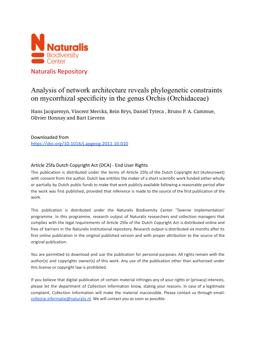2011-06-13
Analysis of network architecture reveals phylogenetic constraints on mycorrhizal specificity in the genus Orchis (Orchidaceae)
Publication
Publication
New Phytologist , Volume 192 - Issue 2 p. 518- 528
• The specificity of orchids for their fungi can vary substantially, from highlyspecialist interactions to more generalist interactions, but little is known about theevolutionary history of the mycorrhizal specificity of orchids.• Here, we used a network analysis approach to investigate orchid mycorrhizalassociations in 16 species of the genus Orchis sampled across 11 different regionsin Europe. We first examined in detail the structure of the network of associationsand then tested for a phylogenetic signal in mycorrhizal specificity and identifiedthe fungi with which the orchids associated.• We found 20 different fungal lineages that associated with species of the genusOrchis, most of them being related to members of the Tulasnellaceae (84.33% ofall identified associations) and a smaller proportion being related to members ofthe Ceratobasidiaceae (9.97%). Species associations formed a nested network thatis built on asymmetric links among species. Evolution of mycorrhizal specificity inOrchis closely resembles a Brownian motion process, and the interaction betweenOrchis and Tulasnellaceae fungi is significantly influenced by the phylogeneticrelationships between the Orchis species.• Our results provide evidence of the presence of phylogenetic conservatism inmycorrhizal specificity in orchids and demonstrate that evolutionary processes maybe an important factor in generating patterns of mycorrhizal associations
| Additional Metadata | |
|---|---|
| , , , , , | |
| doi.org/10.1111/j.1469-8137.2011.03796.x | |
| New Phytologist | |
| Organisation | Staff publications |
|
Jacquemyn, Hans, Merckx, V., Brys, Rein, Tyteca, Daniel, Cammue, Bruno P. A., Honnay, Olivier, & Lievens, Bart. (2011). Analysis of network architecture reveals phylogenetic constraints on mycorrhizal specificity in the genus Orchis (Orchidaceae). New Phytologist, 192(2), 518–528. doi:10.1111/j.1469-8137.2011.03796.x |
|
